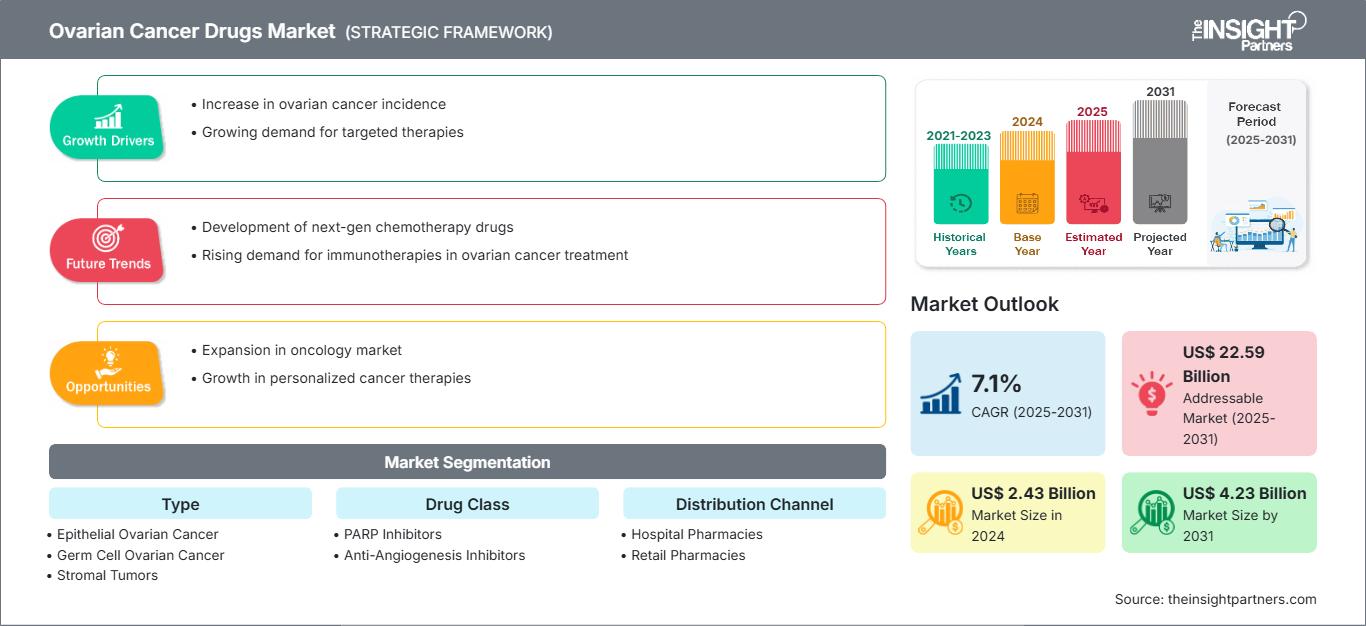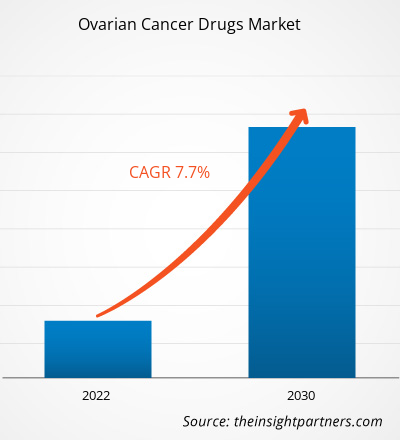卵巢癌药物市场规模预计将从2024年的24.3亿美元增长到2031年的42.3亿美元;预计该市场在2025年至2031年期间的复合年增长率将达到7.1%。
市场洞察和分析师观点:
卵巢癌发病率的上升推动了卵巢癌药物市场的增长。然而,由于不良反应而导致的产品召回阻碍了市场的增长。
增长动力:
卵巢癌发病率的上升推动了对治疗方案的需求
卵巢癌是女性中第七大常见癌症,也是第三大常见妇科恶性肿瘤,分别排在宫颈癌和子宫内膜癌之后。根据世界卵巢癌联盟的报告,每年有 324,000 名女性被诊断患有卵巢癌,207,000 名女性死于该病。此外,大多数卵巢癌患者在诊断时已处于晚期(局部晚期或转移性),因为目前尚无可用于早期发现卵巢癌的公共卫生筛查项目。因此,卵巢癌发病率的上升推动了对有效治疗方案的需求。对于新诊断为晚期卵巢癌的女性,一线治疗方案是减瘤手术和铂类化疗相结合,是标准治疗方法。此外,已获批准的 PARP 抑制剂、奥拉帕尼、鲁卡帕尼和尼拉帕尼等治疗方案是治疗新诊断卵巢癌的突破性选择。使用 PARP 抑制剂治疗晚期卵巢癌也已成为改善临床疗效的有效治疗选择。这些抑制剂为新诊断病例提供长期疗效和无进展生存期 (PFS),在第一次、第二次和第三次铂类化疗完全缓解 (CR) 之后。
自定义此报告以满足您的要求
您将免费获得任何报告的定制,包括本报告的部分内容,或国家级分析、Excel 数据包,以及为初创企业和大学提供超值优惠和折扣
卵巢癌药物市场: 战略洞察

- 获取本报告的主要市场趋势。这个免费样本将包括数据分析,从市场趋势到估计和预测。
您将免费获得任何报告的定制,包括本报告的部分内容,或国家级分析、Excel 数据包,以及为初创企业和大学提供超值优惠和折扣
卵巢癌药物市场: 战略洞察

- 获取本报告的主要市场趋势。这个免费样本将包括数据分析,从市场趋势到估计和预测。
报告细分和范围:
卵巢癌药物市场分析考虑了以下细分市场:类型、药物类别和分销渠道。
细分分析:
按类型,市场细分为上皮性卵巢癌、生殖细胞卵巢癌和间质肿瘤。上皮性卵巢癌细分市场在 2022 年占据了卵巢癌药物市场的最大份额;预计同一细分市场在预测期内的复合年增长率最高,为 8.2%。根据英国癌症研究中心的报告,上皮性卵巢癌是最常见的卵巢癌类型。例如,每 100 个卵巢肿瘤中就有近 90 个 (90%) 是上皮性肿瘤。患有侵袭性晚期卵巢癌的患者目前市场上的治疗选择有限。2022年11月,美国食品药品监督管理局 (FDA) 宣布批准由Elahere ImmunoGen, Inc. 生产的“mirvetuximab soravtansine-gynx”,用于治疗成年上皮性卵巢癌患者。该候选药物用于治疗上皮性卵巢癌的医生推荐剂量为6 mg/kg,每三周静脉输注一次。2024年1月,FDA宣布批准靶向间皮素的抗体-药物偶联物 (ADC)“RC88”获得快速通道资格 (FTD),用于治疗复发性上皮性卵巢癌患者。因此,越来越多的药物获批推动了上皮性卵巢癌领域的卵巢癌药物市场的发展。
卵巢癌药物市场趋势
联合药物疗法
多家医学研究机构正在开发新型联合药物来治疗卵巢癌。2023 年 9 月,皇家马斯登医院的研究人员宣布了一种新的药物联合疗法,该疗法被证明对晚期卵巢癌患者有效。研究人员测试了联合药物疗法对低级别浆液性卵巢癌 (LGSOC) 的效果,LGSOC 是一种罕见的卵巢癌,对治疗的反应率较差。RAMP-201 临床试验是将 avutometinib 药物与 defactinib 联合进行,以研究它们对 LGSOC 患者的协同治疗作用。中期临床试验结果显示,45% 接受药物联合治疗的患者肿瘤显著缩小。联合治疗取得的如此令人满意的临床效果几乎是曲美替尼的两倍,曲美替尼是英国的一种靶向治疗药物,其反应率仅为 26%。2024 年 1 月,FDA 宣布批准 SH-105 联合药物用于治疗乳腺癌和卵巢癌患者。因此,联合药物疗法正在成为一种新趋势,可能会在未来几年推动卵巢癌药物市场的增长。
区域分析:
卵巢癌药物市场报告的范围包括北美、欧洲、亚太地区、南美和中美以及中东和非洲。2022 年,北美占据了卵巢癌药物最大的市场份额。该地区的市场增长得益于顶级公司推出的产品数量不断增加以及主要市场参与者的存在。美国是北美市场最大的贡献者。女性卵巢癌发病率的上升迫使公司和监管机构分别在该地区开发和批准创新药物。此外,合同临床研究组织 (CRO) 数量的增加也有利于北美卵巢癌药物市场的增长。
卵巢癌药物卵巢癌药物市场区域洞察
卵巢癌药物市场区域洞察
The Insight Partners 的分析师已详尽阐述了预测期内影响卵巢癌药物市场的区域趋势和因素。本节还讨论了北美、欧洲、亚太地区、中东和非洲以及南美和中美洲的卵巢癌药物市场细分和地域分布。
卵巢癌药物市场报告范围
卵巢癌药物市场参与者密度:了解其对业务动态的影响
卵巢癌药物市场正在快速增长,这得益于终端用户需求的不断增长,而这些需求的驱动因素包括消费者偏好的演变、技术进步以及对产品益处的认知度的提升。随着需求的增长,企业正在扩展产品线,不断创新以满足消费者需求,并抓住新兴趋势,从而进一步推动市场增长。

- 获取 卵巢癌药物市场 主要参与者概述
行业发展和未来机遇:
卵巢癌药物市场预测可以帮助该市场的利益相关者规划其增长战略。以下列出了市场领先企业的一些战略发展:
- 2022 年 11 月,ImmunoGen 获得 FDA 批准,其 ELAHERE(mirvetuximab soravtansine-gynx)用于治疗对铂类耐药的上皮性卵巢癌成年患者。 ELAHERE 专门获批用于治疗 FRα 阳性铂类耐药性卵巢癌患者。由于治疗方案有限且现有疗法临床疗效不佳,此类患者治疗难度较大。
竞争格局和重点公司:
本卵巢癌药物市场报告中重点介绍的知名公司包括礼来 (Elli Lilly)、阿斯利康 (AstraZeneca)、葛兰素史克 (GSK)、Zielab、ImmunoGen(艾伯维 (AbbVie))、GeneTech(罗氏 (Roche))、Vivesto、Allarity Therapeutics, Inc.、Aeterna Zentaris 和绿叶制药 (Luye Pharma)。这些公司专注于开发新技术、升级现有产品并拓展业务范围,以满足全球日益增长的消费者需求。
- 历史分析(2 年)、基准年、预测(7 年)及复合年增长率
- PEST和SWOT分析
- 市场规模、价值/数量 - 全球、区域、国家
- 行业和竞争格局
- Excel 数据集
近期报告
相关报告
客户评价
购买理由
- 明智的决策
- 了解市场动态
- 竞争分析
- 客户洞察
- 市场预测
- 风险规避
- 战略规划
- 投资论证
- 识别新兴市场
- 优化营销策略
- 提升运营效率
- 顺应监管趋势




















 获取免费样品 - 卵巢癌药物市场
获取免费样品 - 卵巢癌药物市场